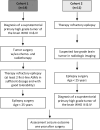Seizure outcomes following epilepsy surgery in pediatric and young adult patients with high-grade brain tumors: Results from a European survey
- PMID: 40022587
- PMCID: PMC12169411
- DOI: 10.1111/epi.18323
Seizure outcomes following epilepsy surgery in pediatric and young adult patients with high-grade brain tumors: Results from a European survey
Abstract
Objective: Epilepsy surgery is a standard treatment for drug-resistant epilepsy, resulting in seizure freedom in a significant number of cases. Although frequently performed for low-grade brain tumors, it is rarely considered for high-grade tumors, despite the impact of chronic epilepsy on quality of life and cognition.
Methods: This retrospective multicenter study across 43 European centers evaluated epilepsy surgery outcomes in children with high-grade brain tumors (World Health Organization grades III and IV). Two cohorts of patients younger than 25 years were studied: (1) those undergoing epilepsy surgery after tumor resection (n = 14) and (2) those initially suspected of low-grade lesions but diagnosed with high-grade brain tumors postsurgery (n = 11).
Results: Eighty percent of patients achieved seizure freedom 1 year after last epilepsy surgery: 71% in Cohort 1 and 91% in Cohort 2. Eighty-four percent were free of disabling seizures (Engel IA-D) after a median follow-up period of 4.3 years (range = 1-15.9 years). No surgery-related deaths occurred. Thirty-two percent of children experienced persistent morbidity, including motor dysfunction, visual impairment, persistent seizures, cognitive deficits, and hydrocephalus.
Significance: Epilepsy surgery is effective for medically refractory epilepsy in children with high-grade central nervous system tumors and should be considered early, as seizure freedom is achieved in the majority of patients. Despite involving numerous epilepsy centers, only 25 patients were recruited, indicating that this method is rarely considered for high-grade brain tumor patients with medically refractory epilepsy.
Keywords: children; drug‐resistant epilepsy; epilepsy surgery; high‐grade brain tumors; seizure freedom.
© 2025 The Author(s). Epilepsia published by Wiley Periodicals LLC on behalf of International League Against Epilepsy.
Conflict of interest statement
None of the authors has any conflict of interest to disclose. We confirm that we have read the Journal's position on issues involved in ethical publication and affirm that this report is consistent with those guidelines.
Figures


References
-
- Cohen AR. Brain tumors in children. N Engl J Med. 2022;386(20):1922–1931. - PubMed
-
- Patel S, Bhatnagar A, Wear C, Osiro S, Gabriel A, Kimball D, et al. Are pediatric brain tumors on the rise in the USA? Significant incidence and survival findings from the SEER database analysis. Childs Nerv Syst. 2014;30(1):147–154. - PubMed
-
- Sanchez Fernandez I, Loddenkemper T. Seizures caused by brain tumors in children. Seizure. 2017;44:98–107. - PubMed
-
- Ullrich NJ, Pomeroy SL, Kapur K, Manley PE, Goumnerova LC, Loddenkemper T. Incidence, risk factors, and longitudinal outcome of seizures in long‐term survivors of pediatric brain tumors. Epilepsia. 2015;56(10):1599–1604. - PubMed
Publication types
MeSH terms
LinkOut - more resources
Full Text Sources
Medical

